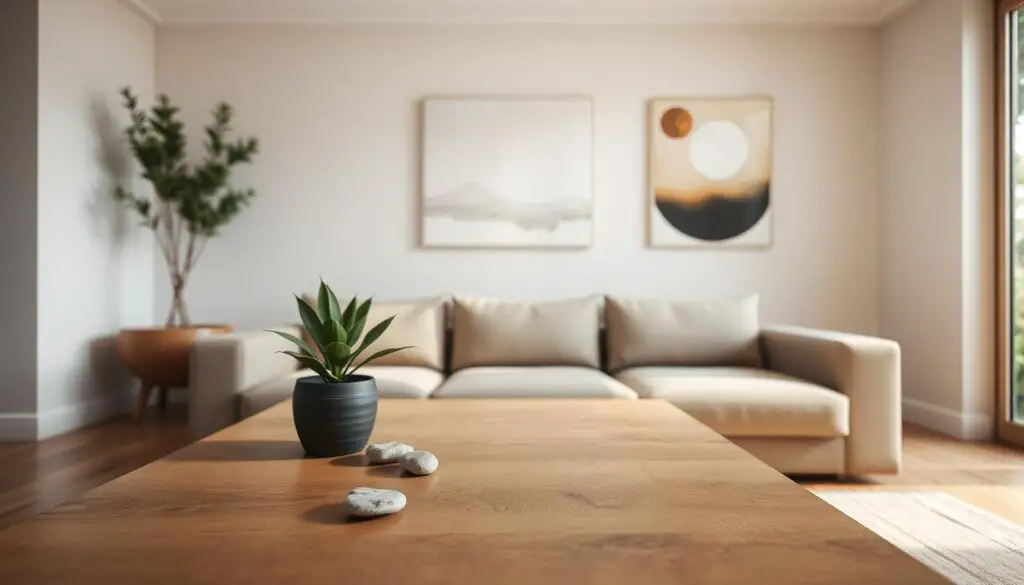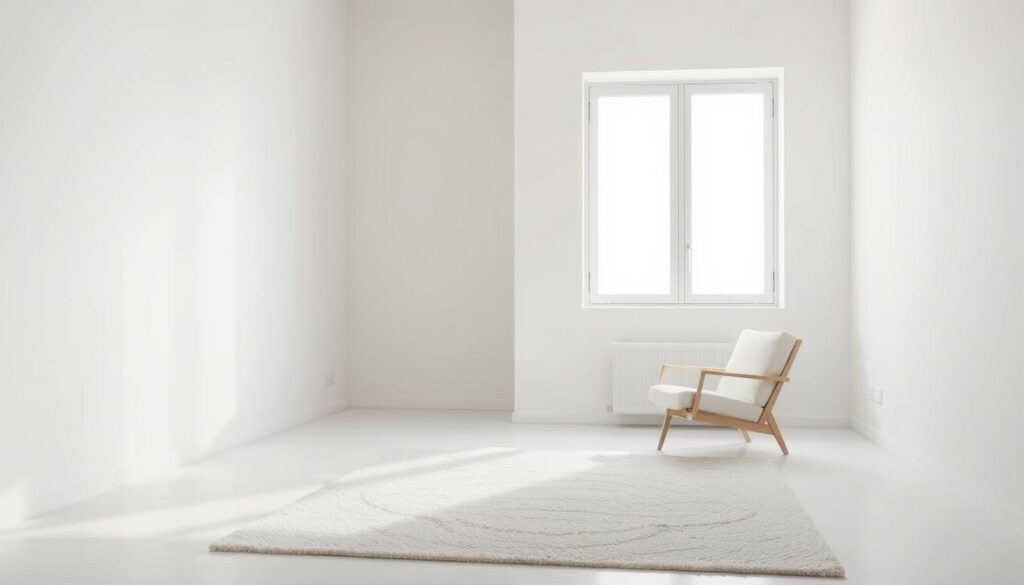
In today’s chaotic world, I find peace in minimalist home decor. Walking into a space with clean lines and neutral tones feels like a breath of fresh air. It shows me the beauty of a well-designed environment.
Minimalism is more than a trend; it’s a way of life. It celebrates simplicity and elegance. By getting rid of clutter, I’ve made a peaceful sanctuary that promotes calm.
When I applied these ideas to my home, I saw big changes. My living room became a place for deep relaxation. It opened up new ways to live mindfully.
In this article, I’ll share my top minimalist home decor tips. You’ll learn how to turn your space into a calm retreat. We’ll cover everything from color choices to furniture, showing you how to create a space that nourishes your mind and spirit.
Key Takeaways
- Minimalism creates a focused and peaceful living environment.
- Choosing neutral colors enhances serenity and calmness.
- Functional furniture can maximize space while maintaining elegance.
- Effective decluttering strategies lead to a more organized home.
- Natural elements add warmth and life to minimalist designs.
- Personal touches bring meaning to your serene space.
Understanding Minimalism in Home Decor
Minimalism turns spaces into calm places. It’s about simplicity and getting rid of clutter. By using minimalist decor, we focus on what’s important.
This approach makes our homes look better and helps us live more intentionally.
The Philosophy Behind Minimalism
Minimalism in design is more than having fewer things. It’s about creating a space that shows our values. It means living without too much and focusing on what’s truly valuable.
Choosing quality over quantity brings happiness. Each item in a minimalist space has a special meaning. This makes us appreciate our surroundings more.
Benefits of Minimalist Design
Minimalist decor does more than look good. It’s good for our mental health too. Studies show it can reduce stress and improve our mood.
It helps us stay focused and mindful. A minimalist home brings peace and clarity. It supports a productive and creative life.
Creating a Minimalist Color Palette
Creating a color palette for a minimalist home is key to its harmony. I choose neutral tones that blend well with other design elements. These colors create a calm background, improving both bedroom and living room designs.
Shades like whites, grays, and soft beiges add elegance. They also make rooms feel open and welcoming.
Choosing Neutral Tones
Neutral tones are the base of minimalist decor. They help create a peaceful atmosphere. Using different textures of neutrals adds depth without clutter.
For example, mixing matte and glossy finishes adds a layered look. This keeps your space minimal while adding a personal touch.
Incorporating Accent Colors
While neutrals set the calm stage, accent colors bring life to your home. I suggest picking one or two bold colors to use thoughtfully. This keeps the space simple and serene.
For instance, a deep blue or warm yellow in a throw pillow can brighten up your living room. The goal is to use each accent with care to keep the minimalist feel.
Selecting the Right Furniture
Choosing the right furniture is key to making a space inviting and practical. The best pieces should be simple yet serve many purposes. This makes any room more efficient.
I look for furniture that does more than one thing. I also choose items with simple lines. These choices help create a space that is both useful and beautiful.
Multi-Functional Pieces
In minimalist design, multi-functional furniture is a must. Think of sofas with storage or coffee tables that turn into desks. These pieces save space and follow the minimalist design rules.
Adding these items to your home makes it more functional. Yet, they don’t lose their beauty. They are key to simple, effective home decor.
Embracing Simple Lines
Simple lines are another important part of minimalist design. Furniture with clean lines makes a space feel open and calm. It helps each piece fit well with the overall look.
Choosing furniture with simple shapes and little decoration creates a light, welcoming space. It’s organized yet feels open.
Furniture choice is vital in a minimalist home. By focusing on both function and design, you can create a space that is both beautiful and simple.
Decluttering Your Space
Decluttering is key to minimalist home decor. It makes your space calm and welcoming. By using good decluttering tips, you can handle unwanted items better. This keeps your home peaceful.
Using the “one in, one out” rule helps you buy wisely. Regular cleaning helps keep your home tidy. This makes your living area more organized.
Strategies for Effective Decluttering
To get a minimalist home, focus on effective methods. Here are some top strategies:
- Use the “one in, one out” rule to avoid clutter.
- Set up regular decluttering times to see what you really need.
- Divide your space into smaller parts to tackle it step by step.
- Ask yourself, “Does this item add value to my life?” when deciding what to keep.
The Importance of Storage Solutions
Good storage is vital for a minimalist look. It keeps clutter away and helps create a calm space. Here are some useful ideas:
| Storage Solution | Description |
|---|---|
| Hidden Cabinets | Install cabinets that blend with walls to keep everyday items out of sight. |
| Stylish Baskets | Use decorative baskets for easy access to items while adding to the decor. |
| Under-bed Storage | Use the space under your bed for seasonal items that you don’t use often. |
| Floating Shelves | Add shelves that keep your space clean while giving room for decorations. |
By using these decluttering tips and minimal decor, you can turn your home into a peaceful sanctuary. These strategies not only improve your space but also fit well with minimalist decor.
Focusing on Lighting
Lighting is key in minimalist interior design, shaping a space’s mood. I focus on natural light and artificial options to boost our home’s look. The right lighting makes our spaces not just functional but also emotionally connected.
Natural Light vs. Artificial Light
Natural light is great for our health. It makes spaces feel open, lifts our mood, and saves energy. Simple tips include using sheer curtains or mirrors to spread light.
Artificial light is needed for comfort at night. I choose soft, diffused lights that fit a minimalist style. Harsh lights can ruin the calm.
Selecting Minimalist Light Fixtures
Choosing light fixtures should be about simplicity and function. Minimalist decor means picking fixtures that fit in without clutter. For example, geometric pendant lights or sleek floor lamps add to a room without overdoing it.
I prefer materials like matte metal or glass for a sleek look. They match minimalist design well.
Incorporating Natural Elements
Adding natural elements to your home can make it feel more peaceful. It brings the outdoors inside, making your space feel welcoming. Plants are a great choice because they add color and help clean the air.
They also improve your mood. Simple home decor tips often talk about how nature helps create a calm space.
Using Plants for a Fresh Atmosphere
Indoor plants can change your home. Plants like snake plants, pothos, or succulents are easy to care for. They add a green look to your space.
They can make you feel happier and clean the air. When picking plants, think about how much light they need and how much care they need. This makes sure they fit well with your life.
Selecting Natural Materials
For minimalist decor, use materials like wood, stone, and cotton. They connect you to nature and keep things simple. Wooden furniture adds warmth, while stone gives a solid feel.
Cotton is soft and doesn’t clutter your space. Choosing these materials carefully helps create a balanced and grounded environment.

Art in Minimalism
Adding art to a minimalist space can really boost its look. It’s important to pick pieces that stand out but don’t clutter the space. Focus on a few key pieces that reflect your style.
Choosing Statement Pieces
Choosing art is a chance to show your taste while keeping things simple. Go for one or two bold pieces that catch the eye. Choose art with soft colors or simple designs to keep the focus on the art, not the clutter.
Use simple frames to add elegance. This fits well with the minimalist idea of using less to mean more.
The Role of Negative Space
Understanding negative space is key in minimalist design. It lets the art and space around it shine. Leaving some walls empty adds balance and thoughtfulness to your design.
By giving your art plenty of room, you highlight it as a special part of your home. Adding a vase or a small plant can also improve the feel without making it too busy. For more tips on minimalist living, see these simple home decor tips.
Simplifying Textiles
In minimalist interior design, the choice of textiles is key. It helps create a simple yet elegant look. I choose high-quality items over many low-quality ones. A luxurious throw, for example, can make a big difference without adding clutter.
Selecting Quality Over Quantity
When picking textiles, quality is more important than how many you have. Fine fabrics make each piece stand out. This adds to the room’s calm atmosphere. Here are some tips:
- Choose timeless materials like linen, wool, or cotton.
- Look for well-made textiles that last longer and stay appealing.
- Find versatile items that fit with different decor styles.
Textures That Enhance Minimalism
Texture is vital in adding warmth and depth to minimalist spaces. Different textures can make a plain space richer. Adding a chunky knit blanket, smooth silk cushions, or woven rugs can do this.
The Importance of Space
Spatial planning is key in minimalist interior design. Open layouts improve room flow and create a sense of freedom. My experience shows that open space makes a room calm and simple.
Creating Open Layouts
An open layout changes how a space feels. Removing walls and barriers makes areas flow smoothly. Use furniture to define spaces without blocking the way.
This approach highlights the beauty of minimalist decor. It lets important pieces shine without feeling too much.
Keeping Pathways Clear
Clear pathways are vital for a minimalist look. Unblocked walkways make rooms feel open and easy to move around. Arrange furniture and decor to keep paths clear.
This practice makes a space organized and peaceful. It follows minimalist home decor tips well.

Personal Touches in Decor
Adding personal touches to minimalist decor makes it unique and meaningful. I choose accessories that reflect important moments in my life. This way, I keep my decor simple yet personal.
Meaningful Accessories
Accessories with sentimental value tell my story in a subtle way. A handmade vase or a photo from a special trip adds character. These items make my home special without cluttering it.
Balancing Personal and Minimalist
It’s important to balance personal items with minimalism. A statement art piece can be a focal point without clutter. I pick a few items that represent my memories and fit my style. This approach keeps my space clear and peaceful.
Maintenance and Upkeep
Keeping a minimalist space clean needs careful routines. Simple cleaning habits make a big difference. They help keep your home peaceful and clutter-free.
Simple Cleaning Routines
Having a cleaning schedule makes life easier. Here are some simple home decor tips that help:
- Set aside time each day for quick clean-ups, focusing on busy areas.
- Follow the ‘one in, one out’ rule to manage your stuff.
- Use weekends for deeper cleaning to keep everything spotless.
Avoiding Clutter Accumulation
To keep a minimalist lifestyle, I use decluttering tips for home. These strategies help avoid clutter:
- Check your belongings often and give away what you don’t need.
- Use storage wisely, showing only what’s essential.
- Get everyone in the house to help keep shared areas clean.
Final Thoughts on Minimalist Living
Reflecting on my minimalist journey, I see that change has been key. Minimalism is more than a trend; it’s a journey of finding what truly matters. Every choice I make shows how my minimalist design evolves.
I’ve learned that minimalism lets me grow, both in my space and myself. It’s a path of discovery and simplicity.
Embracing Change Over Time
Learning to live minimally has taught me the value of being adaptable. I’ve tried different styles and ways to organize. This journey has shown me the importance of a design that reflects me and brings peace.
By embracing change, I’ve made my home feel fresh and personal. It’s a space that rejuvenates me.
My Journey to a Minimalist Home
My journey to a simpler life has had ups and downs. Yet, each step has made me more mindful of my belongings and space. I urge others to find their own path to minimalism.
There’s no one-size-fits-all approach to minimalist design. The goal is to find a balance that brings peace and clarity. This is how we create a calm, clutter-free home that feels truly ours.
